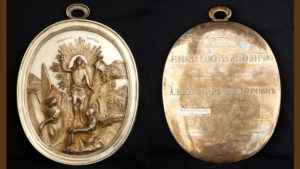Object of the Month: March 2019
The Resurrection
Gilt silver
Vasiliy Fedotovich Il’in (active 1837–57), silver maker
D. Tverskoy (active 1834–50), assay master
St. Petersburg, 1849
For nearly 70 years, the Museum & Gallery has shared with communities at home and abroad its primary focus: a collection of European Old Master paintings ranging from the 14th–19th centuries. Yet, M&G is more than paintings. The Collection includes furniture, decorative arts, textiles, and objects of art as well as Middle-Eastern antiquities with examples from the reputed British Egyptologist, Sir Flinders Petrie. Of special note and often overlooked, however, is the Russian collection, including icons from the 14th through early 20th centuries.
Unlike a Renaissance or Baroque painting of Western Europe idealizing the figures and blending realism and symbolism into the image, icons present an altogether different and somewhat mysterious approach to the same religious subjects. Frequently referred to as “otherworldly,” these meticulously executed images are rich in symbolism and create an awe and respect for the spiritual meaning of the depicted events and characters.
In this example, the icon’s composition and naturalistic qualities reflect a Western treatment of the Resurrection, rather than the painted Orthodox versions. On its face is the inscription, Voskreseniye Christovo, meaning The Resurrection of Christ. And, on the front hanger is inscribed: Christos Voskryes or Christ is Risen.
For its size of a mere 7 7/8″ x 5 5/16″, this beautiful gilt silver oval icon achieves unusual spatial depth. In the foreground is the resurrected Christ carrying the triumphal banner and two angels—one rolling the stone away from the tomb and the other holding the burial cloths. In the middle ground are the three Marys carrying the spices to the tomb on that first day of the week; and in the distance, St. Vladimir’s cross appearing in the rays of the morning sun next to the city of Jerusalem.
In addition to the fine craftsmanship and sophisticated handling of the silver, the icon bears a historically significant inscription engraved on its reverse: To the Sovereign Emperor and Autocrat of all Russians, Nikolai Pavlovitch and the Sovereign Empress Alexandra Feodorovna, on the day of the Resurrection of Christ, April 3rd, 1849. This humble offering from the peasant of Count Sheremetiev, Vasiliy Fedotov Il’in, made by his own hand.
The icon’s inscription reveals that it was a gift to Tsar Nicholas I created by a serf-artist employed by the richest Russian landowner in the 19th century, Count Dmitri Sheremetev. Historical documents reveal that the count was attending a conference for Russian nobility in April 1849, and it was on this occasion that he presented the icon to the Romanov tsar for Easter.
At the bottom there is a hallmark of crossed anchors and a scepter, which means it was made in St. Petersburg. The number 84 denotes the Russian standard content of silver. There is also a documented hallmark for the maker: ФИ, transliterated as FI for the skillful silversmith Fedot Il’yin (active 1837–1857). He began as a serf for Sheremetev, but ultimately earned his freedom and owned his own workshop. He was a master craftsman for creating church accessories and the icon oklads and lampadas.
Historically, the Sheremetev family is recognized for its generous philanthropy, particularly for its contribution and promotion of art and culture in Russia by developing artists and founding and supporting theatres, orchestras, choirs, concert halls. Dmitri, the patron of this icon, was the son of Count Nicholas Sheremetev who married his leading serf-actress Praskovia Ivanova Kovaleva, (her stage name was Zhemchugova). Dmitri’s mother died of tuberculosis 3 weeks after giving birth. Count Nicholas Sheremetev began a charitable institution—a shelter or hospital for the sick and homeless—in memory of his late wife.
As heir to his father’s fortune, he inherited some 180,000 serfs and 15,000 square miles of land. Dmitri served in the military and later married Anna Sergeyevna Sheremeteva (1810-1849), lady-in-waiting to the Empress Alexandra Feodorovna. Years following her death, he married again to Alexandra Melnikova Fosdick (1825-1874). He devoted himself to philanthropic work like his father—investing in hospitals, churches, orphanages, and education.
Erin R. Jones, Executive Director
Published in 2019
